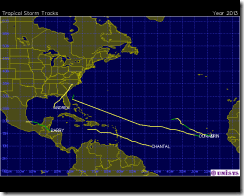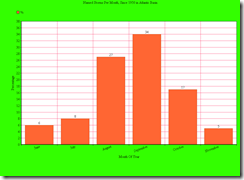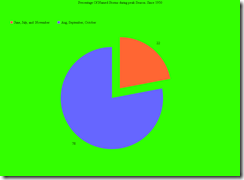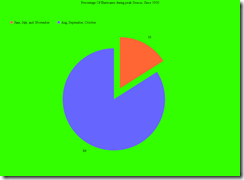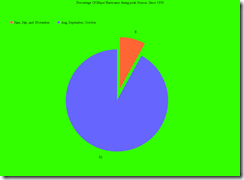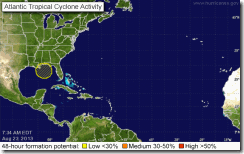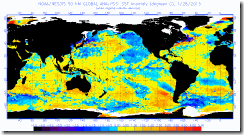Everyone's
Atlantic hurricane forecast for 2013
were calling for above normal to way above normal activity.
For
the 2013 hurricane season NOAA’s Atlantic Hurricane Season
Outlook predicted the following:
70 percent likelihood of 13 to 20 named storms (winds of 39 mph or higher)
7 to 11 would become hurricanes (winds of 74 mph or higher)
3-6 major hurricanes (Category 3,4, or 5: winds of 111 mph or higher)
Respected veteran
hurricane scientist Bill Gray and his team at Colorado State University
called for 18 named
storms during the hurricane season, between June 1 and Nov. 30.
Eight of those are expected
to become hurricanes.
Three of those are
expected to become major hurricanes (Saffir / Simpson category 3-4-5) with
sustained winds of 111 mph or greater.
Believe it or not, this
is a slight reduction from the early April and early June forecasts when the
team called for 18 named storms, nine hurricanes and four major hurricanes.
I said, I was using the weather patterns of past years and decades, along with other factors to make my tropical outlook.
Since 1950 the years 1952,1996, 2007, and 2008 had very similar oceanic and atmospheric characteristics to those forecasted for this years tropical season.
My forecast was this:
"This season will be quite active with 13-18 named systems, with 8-10 becoming hurricanes, four or five (perhaps more) of which will make landfall somewhere in the U.S. Also, I feel 2-4 of these will strike or impact the Northeast and northern Mid Atlantic states. Of the 13-18 named storms 3-4 will be major hurricanes. Once we get toward the end of July and onward I think the season will become quite active. "
So far, named storms in
the Atlantic basin hasn't lived up to mine or anyone's expectations , Jerry makes our 10th named
storm for the season... this is above average
But, we've only had two
hurricanes so far this season....Humberto briefly became a hurricane Sept. 11, a
Category 1 with winds under 95 mph. It was named a hurricane just three hours
before it would have been the latest first hurricane since the satellite era. The
other hurricane was Ingrid Which momentarily became a Category 1 before
landfall in Mexico.
So while activity is
above normal, the intensity of these tropical cyclones hasn't come any way near
what was forecasted.
Tracks for the named systems for the 2013 season
With records going
back to 1851, Dennis Feltgen, a spokesman for the U.S. National Hurricane
Center, said there had been only 17 years when the first Atlantic hurricane
formed after Sept. 4.
Feltgen said "The all-time record
was set in 1905, when the first hurricane materialized on Oct. 8".
In an average season the seasons first hurricane shows up by Aug. 10, with the
second hurricane quick on its heals on
Aug. 28 and the first major hurricane normally forms by Sept. 4.
As I've said in post and on my Facebook page, since the dawn of the satellite
era, started in 1967. Hurricane Gustav
set the modern record on September 11, 2002 as the latest date for the first
hurricane to arrive.
The Accumulated
Cyclone Energy index -- a rating system that compares the intensity of storm
seasons -- would normally be around 55 for the Atlantic. It's now a paltry 16.
Globally the rating is a stunning 255, roughly half of what we should see this
time of year.
normally when an ocean basin
kicks up a fuss on one part of the globe, usually another ocean basin is quiet.
Nature tends to balance itself that way. This year, according to the ratings,
storm activity in all the world's ocean basins is below normal.
So what is going on?
We had a very
strong Bermuda high for most of the
Summer...This helped suppresses tropical
cyclone development.
Most of the season has
seen a very stable atmosphere over the tropical Atlantic.
In a normal El Nino
year the tropical water in the Pacific west of South America are warmer than
normal, this leads to a lot of wind shear across the Caribbean , which
suppresses Tropical Cyclones
Now while, this has
not been a El Nino year, the waters in the tropical Pacific have been above
normal, perhaps this has something to do with all the wind shear we've been
seeing.
The location of the
Jet Stream for a good part of the Summer had been farther south than average
Making it wet in both
the Northeast and Southeast along the Eastern Seaboard... this could also be
helping in creating shear......
There also has been an
ongoing drought in northeast Brazil.
These could have had a major role in the placement of the Tropical Upper Tropspheric Trough
(TUTT) for the 2013 season.
TUTT is an upper level
trough that helps with convection in the tropics
It is normal to see it over the Atlantic and
Pacific for part of the year.
The location of the
TUTT is key as to if it will aid or hinder tropical cyclone development
TUTT helps support
vertical wind shear.. Normally south of the TUTT you have strong westerly wind
shear ...Tropical cyclones don't like environments like that.....But north of the
TUTT the wind shear is normally less...so tropical cyclones that form there
have a better chance for development.
The TUTT isn't always
bad, there are times when they can help build better outflow of the storms
center.....there have been times where the TUTT became cut off and became a
tropical cyclone.
TUTT over the Atlantic
basin first appears in June, strengthens in July and August, and then weakens
in September and October. During August (the start of prime time for Atlantic
tropical cyclones), the TUTT tilts from southwest to northeast, spanning from
Cuba to roughly latitude 35 degrees North at around 250mb
This season there were
several times where the placement of the TUTT caused strong west and southwest winds aloft which
helped suppress tropical cyclone development.
The SAL layer... I
feel this was the biggest factor this year....
tropical storms and hurricanes develop and intensify by
feeding off warm, rising, moist air. But, the Atlantic's hurricane breeding
ground has been dominated by dry, sinking air for much of the summer....normally you don't see these huge
dust storms coming off the African Coast during the hurricane season...... The
High pressure in the Atlantic was too far north... if it had been farther south it would have forced the air to
come off the Congo instead of the Sahara Desert ...The Congo is all rainforest, therefore it has a
lot more moisture......this would have been much more conductive for tropical cyclone development.
I don't like to see death and destruction, so a slow season is a good thing. one thing I want to mention is the almost always present high pressure over the eastern
part of the Country has helped protect the Northeast from the few storms that
did form.
From the hurricane climatology standpoint, storms ordinary
form closer to the U.S. coast later in the season, like Hurricane Sandy last
year.”
Looking back at the records, in the past 60 years there have
been three seasons with no named storms at any time from September 20th through
September 26th: 1991, 1997 and 2009. All of these were El Nino seasons,
however, there have been other El Nino seasons during this 60 year period -
including 2002 and 2004 which were active seasons. In 1993, a slightly positive
ENSO Neutral year, there were no named storms after September 21st. So far,
2013 is a slightly negative to an Neutral ENSO season.
Looking at the Teleconnections, most of the same atmospheric
conditions that have so far interfered with tropical cyclone development could
persist into November.
Looking at everything, I don’t see any significant changes
for the Atlantic Basin for the rest of the 2013 hurricane season. But we will see.










